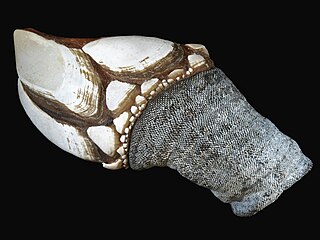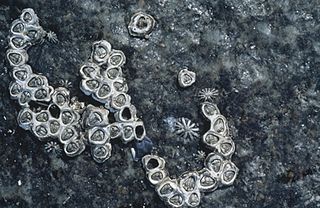
Barnacles are arthropods of the subclass Cirripedia in the subphylum Crustacea. They are related to crabs and lobsters, with similar nauplius larvae. Barnacles are exclusively marine invertebrates; many species live in shallow and tidal waters. Some 2,100 species have been described.

Goose barnacles, also called percebes or turtle-claw barnacles or stalked barnacles or gooseneck barnacles, are filter-feeding crustaceans that live attached to hard surfaces of rocks and flotsam in the ocean intertidal zone. Goose barnacles formerly made up the taxonomic order Pedunculata, but the group has been found to be polyphyletic, with its members scattered across multiple orders of the infraclass Thoracica.

The Chthamalidae are a family of chthamaloid barnacles, living entirely in intertidal/subtidal habitats, characterized by a primary shell wall of eight, six, or four plates, lacking imbricating plate whorls, and either membraneous or more rarely calcareous basis. They are not found below immediate subtidal habitats, and more likely are found in the highest tier of shallow-water barnacle fauna. They can be found in the most rigorous wave-washed locations, and some species are found in the surf zone above high tide mark, only receiving water from wave action at high tide. The family includes at least 56 recognized species.

Megabalanus is a genus of barnacles in the family Balanidae. Members of the genus grow to 7 cm (2.8 in) in length and inhabit the lower intertidal zone.

Austromegabalanus is a genus of giant barnacles. It contains both extant and extinct species.

Lepas anserifera is a species of goose barnacle or stalked barnacle in the family Lepadidae. It lives attached to floating timber, ships' hulls and various sorts of flotsam.

Notochthamalus scabrosus, the only species in the genus Notochthamalus, is a species of barnacle found along the south-western and south-eastern coasts of South America, from Peru to the Falkland Islands. The species is found almost exclusively higher in the intertidal zone than the mussel Perumytilus, often codistributed with the confamilial barnacle Jehlius cirratus and Balanus flosculus.

Megabalanus tintinnabulum is a species of large barnacle in the family Balanidae. It is the type species of the genus. The specific name comes from the Latin tintinnabulum meaning a handbell and probably refers to the fact that small groups of barnacles resemble clusters of miniature bells.

The Chthamaloidea are a subdivision of Balanomorpha proposed by Newman and Ross to include barnacles with shell wall composed of rostrum, carina, and one to three pairs of latera, rarely supplemented with one or more whorls of basal imbricating plates. The rostrolatus enters the sheath, but rarely fuses with the rostrum, as in the three higher superfamilies. Shell plates are simple in construction, solid, and incorporate organic chitin between carbonate layers. Opercular plates are deeply interlocked, and in some genera, may become concrescent with age. Soft part morphology includes concave labrum without notch in the central part. Cirrus III more resembles Cirrus IV than II, or may be intermediate in structure. Caudal appendages present in some species.

Catomerus is a monotypic genus of intertidal/shallow water acorn barnacle that is found in warm temperate waters of Australia. The genus and species is very easily identified by whorls of small plates surrounding the base of the primary shell wall; no other shoreline barnacle species in the Southern Hemisphere has that feature. This species is considered to be a relic, as these plates are found only in primitive living lineages of acorn barnacles or in older fossil species. The fact that this is an intertidal species is unusual, because living primitive relic species are often found in more isolated habitats such as deep ocean basins and abyssal hydrothermal vents.

Catophragmus is the originally named genus of the family Catophragmidae. At present, it is monotypical. It is a shallow water acorn barnacle of the Tropical Western Atlantic and Caribbean characterized by small accessory imbricating plates surrounding the base of the shell wall.
Chamaesipho is a genus of four-plated notochthamaline barnacles in the Pacific Ocean limited to Australian/New Zealand temperate waters. They are intertidal in preference, and tend to form crowded columnar colonies. They can be identified in the field by having a four-plated wall, an unfused rostrum, and narrow opercular plates. Elminius, which also inhabits the same area, has four plates in its shell wall. However, in Elminius, the rostrum and rostrolatera are fused completely, and the compound rostrum receives the alae of the adjacent carinolaterals. In Chamaesipho, the unfused rostrum bears alae, and closely resembles the carina in appearance.

Chamaesipho brunnea is an intertidal barnacle common in New Zealand, in both the North Island and the South Island. Juveniles have six shell wall plates, reducing to four in adults, and with age, all plates become concrescent, with no trace of sutures inside or out. Shell is brown colored. The related, and sometimes associated Chamaesipho columna is much smaller in size, by nearly half, while Elminius, which can associate with both species, also has four shell wall plates, but plates remain distinct at all stages. The shell of C. columna corrodes to a pitted surface, while that of C. brunnea has a lamellar corrosion.

Chamaesipho tasmanica is an intertidal shoreline barnacle of Australia. Its principal range centers in New South Wales, and Tasmania. Columnar colonies can be found on high intertidal rocks relatively free of dense seaweed. Individuals are small, less than 15 mm, and grayish in color.

Chamaesipho columna is the type species for the barnacle genus Chamaesipho. Originally, species concept, as refined by Darwin472 consisted of C. columna. Spengler's 1790 description included specimens from "Otaheite" (Tahiti), which were far larger than any of the three described species. As Chamaesipho is restricted to Australia and New Zealand, and Spengler's Tahiti material lacked opercular plates, it is no longer included as Chamaesipho. Spengler's written description agrees with Chamaesipho.472 Spengler's Tahiti material is thought to be New Zealand Epopella, mislabeled.
Rehderella is an unusual and monotypic barnacle genus restricted to Easter Island and Pitcairn Island. Rehderella belyaevi is its only species.
The barnacle genus Nesochthamalus was erected by Foster & Newman, 1987, to include sole species Chthamalus intertextus originally named by Darwin in 1854. It is widespread on islands in Western Pacific Ocean, including Hawaii, and presents combinations of unusual features which make easily recognizable for field workers. These include dirty white shell exterior with deep purple colored interior, operculars colored purple. Opercular plates on each side calcify together in all but youngest individuals, and cannot be separated or easily distinguished from each other. This feature is shared only by Rehderella belyaevi, but in latter species, scutum and tergum can be distinguished by raised ridge replacing old articular margin. Unique feature of Nesochthamalus is its basis. In young individuals, it is entirely membraneous, and with age, becomes secondarily calcareous progressively inwards, leaving only the center membraneous. As the basis calcifies, it rises off the substrate forming a saucer shape when viewed from the side. In addition, interior of shell is secondarily calcified.

Caiman wannlangstoni is an extinct species of caiman that lived in what is now the Amazon Basin and surrounding areas during the Middle and Late Miocene. Fossils of C. wannlangstoni have been found in the Pebas Formation near Iquitos in Peru and include partial skulls and isolated skull bones. Other fossils were uncovered from the Urumaco Formation in Venezuela and the Laventan Honda Group of Colombia. The species was first described in 2015. Features that in combination distinguish C. wannlangstoni from other caimans include a deep snout, a wavy upper jaw margin, a large and upward-directed narial opening, and blunt teeth at the back of the jaws. Based on the sizes of the skulls, its estimated body length is about 211 to 227 centimetres.
Vulcanolepas osheai, commonly referred to as O'Shea's vent barnacle, is a stalked barnacle of the family Neolepadidae. This species is endemic to New Zealand.

The Faluns Sea is a former sea which covered Western France from 16 to 3.5 Ma. It spreads from Normandy to Vienne by forming an inlet through what is today Brittany, Anjou, Touraine and Blésois.












